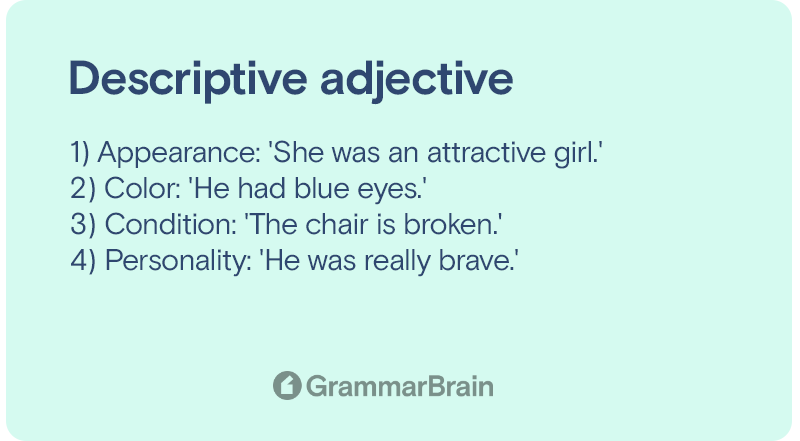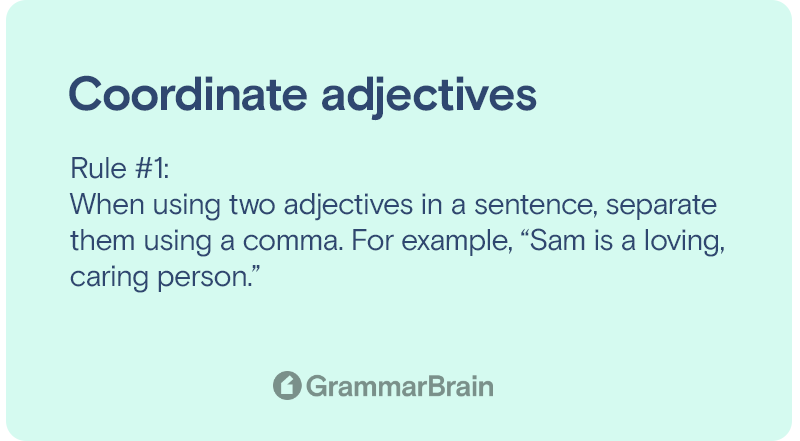What is an adjective? How does an adjective work? An adjective is a word that’s used to describe places, people, or things. Words like ‘young’, ‘happy’, and even ‘red’, are some examples of adjectives. Learn what are adjectives through this article.
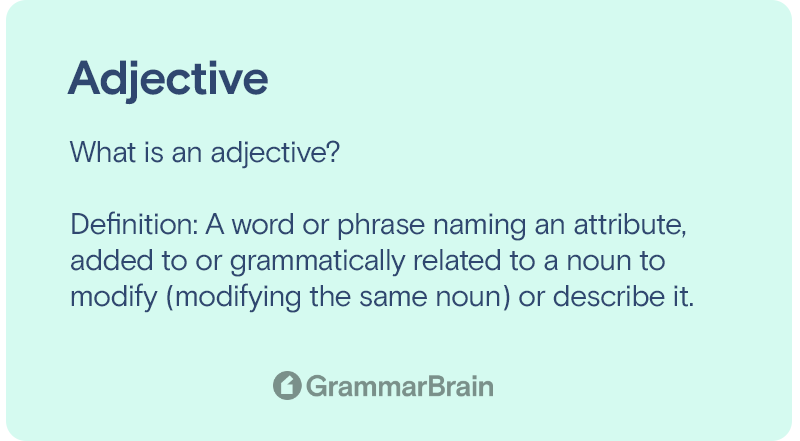
What is an Adjective?
Adjectives are used to describe the qualities or the states of being, of nouns. They are defined as, “a word or phrase naming an attribute, added to or grammatically related to a noun to modify or describe it.”
| Part of Speech | Definition |
| Adjective | a word or phrase naming an attribute, added to or grammatically related to a noun to modify (modifying the same noun) or describe it. |
What Do Adjectives Do?
Adjectives are used to modify nouns and sometimes pronouns as well. They enable you to add meaning to the noun, and also to describe it. The adjective meaning essentially states that adjectives are used to modify nouns.
Why Do We Have Adjectives In The English Language?
Adjectives help you to add meaning to the sentence, and when used correctly, can help you reduce your word count as well. Adjectives are essential in the English language as they help you to describe the subject of the sentence.
Learn about adjective meaning through this guide.
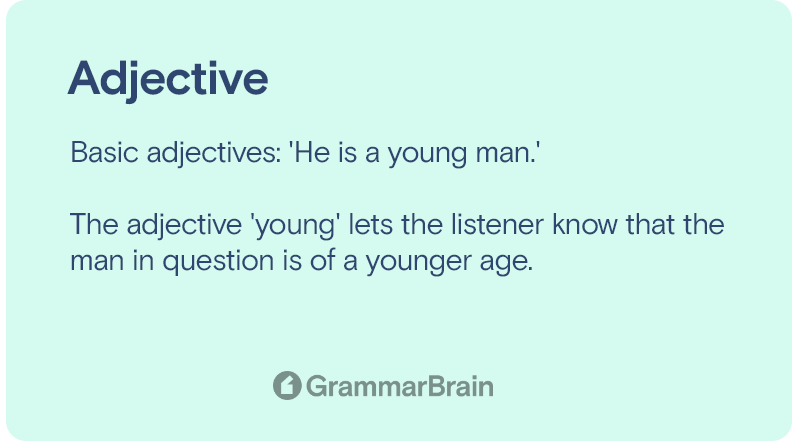
Understanding Adjectives Before a Noun
Usually, adjectives will be placed before the noun that it’s describing. This way, it modifies the noun. They can also be called attributive adjectives.
Grammar Rules
When an adjective is placed before a noun, it ends up modifying that noun.
Without the adjective, the meaning of the noun would change.
Take for example the term ‘old man.’
Here, the word ‘old’ is an adjective that’s used to modify the word ‘man’.
Without this adjective, the man can be of any age. But when you say ‘old man’, you’re describing what the overall age of the man is.
You can also use adjectives to modify pronouns as well. Take, for example, the sentence, ‘She’s a happy one.’ Here, the adjective ‘happy’ is used to modify the pronoun ‘one.’
Sentence Examples
1) ‘He is a young man.’
The adjective ‘young’ lets the listener know that the man in question is of a younger age.
2) ‘Bring me the red coat’.
Here, the adjective ‘red’ informs the listener that the coat they should bring is one colored red.
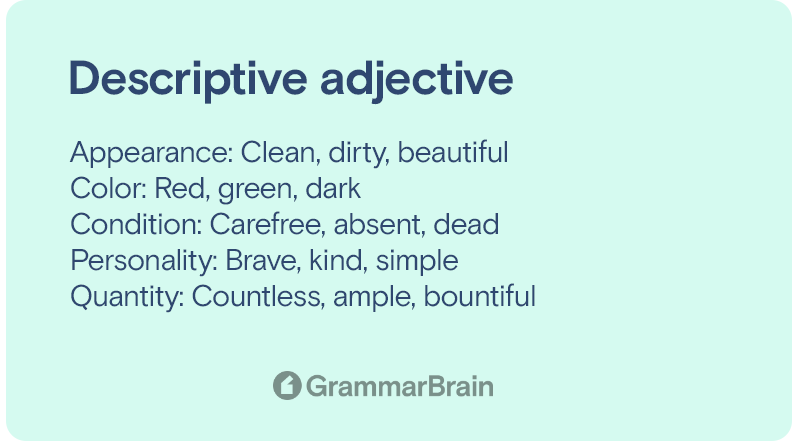
Understanding Adjectives Immediately After a Noun
An adjective can also be placed after a noun. An example of this is the sentence ‘Jill was young.’ In this example, the adjective comes after the linking verb ‘was’. These kinds of adjectives are known as predicate adjectives.
But sometimes, you’ll also find adjectives being used immediately after a noun. These kinds of adjectives are known as postpositive adjectives. More commonly, these are used following pronouns.
Grammar Rules
Adjectives can be placed after a noun or a pronoun. The term ‘time immemorial’ is an example of this. Here, the adjective ‘immemorial’ adds meaning to the noun ‘time’.
Adjectives that are placed immediately after a noun, are usually used following pronouns.
You can also add an adjective after a linking verb. Take, for example, the sentence ‘She seemed happy.’
Here, the adjective ‘happy’ follows the linking verb ‘seemed.’
Sentence Examples
1) ‘He looks like someone interesting.’
2) ‘She wasn’t among those present.’
Descriptive Adjectives (Word List)
Descriptive adjectives, as the name suggests, are used to describe a noun or a pronoun. You’ll usually find them in certain categories.
Which include:
- Appearance: Clean, dirty, beautiful
- Color: Red, green, dark
- Condition: Carefree, absent, dead
- Personality: Brave, kind, simple
- Quantity: Countless, ample, bountiful
- Sense: Warm, cold, sweet
- Shape and Size: Circular, angular, rectangular
- Time: Daily, old, ancient
Sentence Examples With Descriptive Adjectives
Here’s a sentence example for each kind of descriptive adjective.
1) Appearance: ‘She was an attractive girl.’
2) Color: ‘He had blue eyes.’
3) Condition: ‘The chair is broken.’
4) Personality: ‘He was really brave.’
5) Quantity: ‘The harvest was bountiful.’
6) Sense: ‘The food was bitter.’
7) Shape and Size: ‘The swimming pool was deep.’
8) Time: ‘I go to school daily.’
The descriptive adjectives are marked in bold.
How Do Adjectives and Determiners Work Together?
Traditionally, words such as ‘his,’ ‘many,’ ‘a’, ‘this,’ and more, are placed in the same classification as adjectives. More recently, these words are being classified using the term ‘determiners.’
This is why when people usually think of adjectives, descriptive adjectives come to their minds. Now that you know what is an adjective, it’s time to learn about determiners.
With determiners in the picture, there are now a total of nine parts of speech.
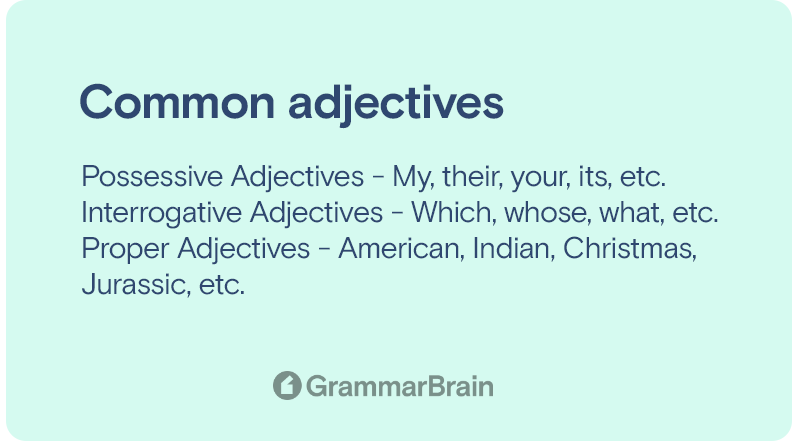
Possessive Determiners and Adjectives
Possessive determiners include the words ‘my,’ ‘his,’ ‘her,’ ‘your,’ ‘their,’ ‘our,’ ‘whose’ and ‘its.’
Now let’s look at an example sentence. ‘The man opened the door for his wife.’
Here, the possessive determiner is ‘his,’ and it shows whose wife the man opened the door for.
Demonstrative Determiners and Adjectives
Demonstrative determiners include the words ‘these,’ ‘that,’ ‘those,’ and ‘this.’
Now let’s look at an example sentence to see how they work.
‘That man has been silent for a long time.’
Here, the demonstrative determiner ‘that’ is used to denote which man is being spoken of.
Nouns Used as Adjectives
Sometimes, nouns can also be used as adjectives. Take, for example, the term ‘silk gloves.’
Here, the noun ‘silk’ is used to describe what kind of a glove it is. In the term ‘donut shop,’ both ‘donut’ and ‘shop’ are nouns.
However, when put together, they modify each other. You’re able to tell what kind of a shop it is – a donut shop.
Grammar Rules
In order to use a noun as an adjective, that noun should be capable of modifying the noun it’s being placed next to. In the term ‘electricity board,’ the noun ‘electricity’ is helping to determine what kind of a board it is.
Consider the term ‘fall colors,’ as well. The noun ‘fall’ describes what kind of colors can be seen. The two nouns work together to add meaning to the sentence.
Sentence Examples
1) ‘There was a fruit fly on my glass.’
2) ‘Our team won the boat race.’
Infinitives Used As Adjectives
You can also use infinitives as adjectives. An infinitive verb, such as ‘to run, ‘to swim,’ and ‘to walk,’ can all be used to modify nouns.
Grammar Rules
Nouns can be modified using infinitive verbs. Infinitives can also end up heading the phrase itself.
Sentence Examples
1) ‘He gave her the order to run.’ Here, the infinitive verb ‘to run’ describes the noun ‘order.’
2) ‘He told his friend to jump.’ In this case, the infinite verb ‘to jump’ describes what the noun ‘friend’ was asked to do.
Order of Adjectives
In case you want to use more than two adjectives together, then there’s a particular order that you need to follow. Knowing the meaning of adjectives is also important to understand the order of adjectives.
Although it’s rare for people to use more than three adjectives in the same sentence, if you find yourself using more adjectives, follow the following order:
Placement and Type of Adjective
The placement and type of adjective help determine the order that two or more adjectives can be placed.
The order is as follows:
1) Article and demonstrative or possessive determiners. Words like ‘a,’ ‘the,’ ‘my,’ ‘that,’ ‘this,’ and other similar words come first.
2) Quantity: These could be any number, such as ‘one,’ ‘seven,’ ‘thirty-three,’ and more.
3) Observation And Opinions: These include words like ‘smart,’ ‘pretty,’ ‘witty,’ and more.
4) Size: Words like ‘small’ and ‘large’, are placed next.
5) Physical Quality: This can include words like ‘clean,’ ‘cluttered,’ and ‘dirty.’
6) Shape: Words like ‘circular,’ ‘square’, and ‘short’ are used next.
7) Age: Words like ‘old,’ ‘young,’ and others come next.
8) Color: Any colors, like ‘red,’ ‘green,’ and ‘blue’, come next.
9) Religion Or Origin: The nationality of a person, like ‘German,’ or the religion they follow, like ‘Christianity,’ comes next.
10) Material: Words like ‘wooden,’ ‘metal,’ and others, fall into this category.
11) Type: Terms like ‘all-purpose’ and ‘L-shaped’ among others, should be placed next.
12) Purpose or Attributive Noun: These should be used last and includes words like ‘service,’ ‘cooking,’ and ‘drinking.’
You should note that while this list is not universally agreed upon, it’s still commonly used. Age and shape are the two areas that people often disagree upon.
Sentence Examples
1) ‘Have you seen my two brown wooden spoons?’
Here, the possessive determiner ‘my’ comes first, followed by the quantity ‘two,’ and then the color ‘brown.’ Finally, the material ‘wooden’ is the last adjective used.
2) ‘Talk to the old French policeman.’ Here, the first adjective is ‘old,’ as age comes before origin. ‘French’ is used to describe the origin of the policeman.
Commas and Adjectives
To better understand when you should place a comma between adjectives, you’ll need to know what coordinate and cumulative adjectives are.
Cumulative Adjectives
In the case of cumulative adjectives, you can build specificity with each adjective. This is why you should never insert commas between two cumulative adjectives. They should also follow the order of adjectives that’s been listed above.
Sentence Examples
1) ‘A dark brown wooden spoon.’
2) ‘A beautiful red butterfly.’
In both cases, the order of adjectives needs to be followed. You also won’t be adding commas between the adjectives.
Coordinate Adjectives
When it comes to coordinate adjectives, they describe the noun independently. As a result, you can place them in any order you like.
You should use commas to separate the adjectives, and you may use the word ‘and’ as well.
Sentence Examples
1) ‘A red, lumpy vase.’
2) ‘A lumpy, red vase.’
Changing the order of coordinate adjectives doesn’t affect the sentence’s meaning.
The Many Types of Adjectives
There are different types of adjectives that you should know about. They include:
Compound Adjectives
Adjectives aren’t always used in isolation. You can use two or more adjectives to modify a noun as well. When you use more than one adjective, you’re using compound adjectives.
Grammar Rules
You’ll need to use hyphens to combine the two adjectives and indicate that they are one term.
Sentence Examples
1) ‘He was a good-looking man.’
2) ‘They have a close-knit family.’
Adjective Phrases
An adjective phrase is a word group that uses the adjective describing the noun.
Grammar Rules
In sentences, adjectives can be used alongside modifiers, such as adverbs and prepositional phrases. This means that a single adjective can end up being featured in a phrase where more than one adjective is used.
Examples
1) ‘The butterfly is a really beautiful insect.’ Here, the adjective phrase ‘really beautiful’ is used to describe the insect.
2) ‘The tiger is an especially deadly predator.’ Here, ‘especially deadly’ are used together to describe what the tiger is.
Adjective Clauses
Clauses can also be used as adjectives. An adjective clause contains multiple adjectives alongside a subject and a verb.
Grammar Rules
When using an adjective clause, the clause will be linked to the noun that’s being described. A relative pronoun or a relative adverb is used to make this link. As with clauses in general, there should be a subject and a verb.
Examples
1) ‘People who write about history aren’t always the people who make history.’
2) ‘People who make history are the ones who get to tell their story ‘
Personality Adjectives
These are adjectives that are used to describe the personality of a person. It can include words like ‘brave,’ ‘cheerful,’ ‘cowardly,’ and more.
Grammar Rules
Personality adjectives can help you describe the character of a person or their personality. It is usually placed before the noun that is being modified.
Examples
1) ‘She was a brave girl.’
2) ‘He is a kind boy.’
In both these cases, the adjectives provide a personality attribute to the person, the noun.
Comparative Adjectives
Comparative adjectives compare two things, two people, and more. Words like ‘smarter,’ ‘taller,’ and ‘longer’ are some examples of comparative adjectives.
Grammar Rules
Comparative adjectives help compare two people or things. It shows what quality one has that’s better compared to the other.
Examples
1) ‘His cat is nicer than my cat.’
2) ‘Isaac is smarter than Mike.’
Predicate Adjectives
A predicate adjective modifies or describes the subject present in the sentence. It’s usually linked to the subject using a linking verb.
Grammar Rules
To use a predicate adjective, you’ll need to place it after the linking verb. It is used to describe the subject of the sentence.
Examples
1) ‘The boy is very happy.’
2) ‘The joke was very funny.’
Possessive Adjectives
These adjectives are used to indicate possession. They include words like ‘my,’ ‘your,’ ‘her,’ and more.
Grammar Rules
Possessive adjectives are used to express ownership or possession within a sentence.
Examples
1) ‘This is my home.’
2) ‘That is her notebook.’
Proper Adjectives
Proper adjectives are also referred to as common adjectives. These can be used to describe people, places, and things.
Grammar Rules
Proper adjectives should always be used such that they modify the noun or pronoun in the sentence. They can be placed before or after the noun. Proper adjectives are usually capitalized, as they are derived from proper nouns.
Examples
1) ‘That is a Japanese melon.’
2) ‘The book has Orwellian influences.’
Demonstrative Adjectives
Demonstrative adjectives are specifically used to describe the position that an object or a person has, in space as well as time.
Grammar Rules
Demonstrative adjectives are called determiners as well. They are used to identify nouns or pronouns and to express the position of the noun or pronoun.
Examples
1) ‘This is her home.’
2) ‘That’s the direction to her home.’
Superlative Adjective
Superlative adjectives are used to describe objects at the higher or lower limit of a certain quality. Examples include words like ‘the tallest,’ ‘the highest’, and more.
Grammar Rules
Superlative adjectives are used in sentences where the subject is being compared to a group of objects. Superlative adjectives are usually used to describe extremes.
Examples
1) ‘He is the tallest boy in the class.’
2) ‘That building is the tallest in the city.’
Irregular Adjectives
An irregular adjective is an adjective that doesn’t change form when er/est is added to it. An example of this is the word ‘good.’ You can’t turn the word into ‘gooder’ or ‘goodest,’ as that would be grammatically incorrect.
Grammar Rules
Where Irregular adjectives are concerned, you’ll need to know the comparative and superlative form of the adjective. For the word ‘good,’ the comparative term is ‘better’ while the superlative term is ‘best.’
Examples
1) ‘He is a good boy.’
2) ‘He is the best athlete on the team.’
Adjectives That Start With A
- Accomplished
- Advanced
- Altruistic
- Ample
- Active
- Angry
Adjectives That Start With B
- Better
- Bitter
- Bold
- Bossy
- Brave
- Broken
Adjectives That Start WithC
- Careful
- Close
- Clear
- Complex
- Compassionate
- Clueless
Adjectives That Start With D
- Deep
- Definitive
- Dense
- Digital
- Defensive
- Dark
Adjectives That Start With E
- Ecstatic
- Enormous
- Exalted
- Elegant
- Early
- Easy-going
Adjectives That Start With F
- Fancy
- Favorite
- Flawed
- Firm
- Filthy
- Fluffy
Adjectives That Start With G
- Generous
- Grotesque
- Grandiose
- Good
- Glossy
- Growing
Adjectives That Start With H
- Handsome
- Harmful
- Heartfelt
- Heavy
- Helpful
- High
Adjectives That Start With I
- Icy
- Identical
- Impeccable
- Incredible
- Impossible
- Impolite
Adjectives That Start With J
- Jaded
- Jagged
- Jittery
- Juicy
- Jumbo
- Junior
Adjectives That Start With K
- Kind
- Kooky
- Knotty
- Kosher
- Key
- Keen
Adjectives That Start With L
- Lavish
- Lame
- Live
- Long
- Loud
- Loose
- Large
Adjectives That Start With M
- Mammoth
- Majestic
- Merry
- Meek
- Medical
- Mild
Adjectives That Start With N
- New
- Naive
- Nice
- Novel
- Next
- Nasty
Adjectives That Start With O
- Obedient
- Oblong
- Old
- Oily
- Original
- Opulent
Adjectives That Start With P
- Pale
- Paltry
- Plump
- Pleasant
- Playful
- Past
Adjectives That Start With Q
- Quaint
- Qualified
- Quirky
- Quick
- Quiet
- Quixotic
Adjectives That Start With R
- Radiant
- Rare
- Rigid
- Rapid
- Rich
- Robust
Adjectives That Start With S
- Sad
- Safe
- Salty
- Shady
- Shiny
- Shy
Adjectives That Start With T
- Thorny
- Trim
- Tiny
- Tight
- Tricky
- Tepid
Adjectives That Start With U
- Unique
- Unsightly
- Unruly
- Unfit
- Upright
- Usable
Adjectives That Start With V
- Vibrant
- Violent
- Vital
- Virtual
- Vivid
- Violet
Adjectives That Start With W
- Warm
- Weak
- White
- Weekly
- Whimsical
- Wet
Adjectives That Start With Y
- Yearly
- Yellow
- Young
- Youthful
- Yummy
- Yawning
Adjectives That Start With Z
- Zany
- Zealous
- Zesty
- Zigzag
More on adjectives
More resources on adjectives:
Education:
- Demonstrative Adjective
- Adjective Clause
- Possessive Adjective
- Superlative Adjective
- Nouns as Adjectives
- Adjective Phrase
- Irregular Adjective
- Compound Adjective
- Proper Adjective
- Comparative Adjective
- Predicate Adjective
- Coordinate Adjective
- Cumulative Adjective
- Adjectives Describing Personality
- Superlatives and Comparatives
- Order of Adjectives
- Adjectival Participle
Adjective Lists:
- Adjectives that start with A
- Adjectives that start with B
- Adjectives that start with C
- Adjectives that start with D
- Adjectives that start with E
- Adjectives that start with F
- Adjectives that start with G
- Adjectives that start with H
- Adjectives that start with I
- Adjectives that start with J
- Adjectives that start with K
- Adjectives that start with L
- Adjectives that start with M
- Adjectives that start with N
- Adjectives that start with O
- Adjectives that start with P
- Adjectives that start with Q
- Adjectives that start with R
- Adjectives that start with S
- Adjectives that start with T
- Adjectives that start with U
- Adjectives that start with V
- Adjectives that start with W
- Adjectives that start with X
- Adjectives that start with Y
- Adjectives that start with Z
FAQs
What is an adjective?
The definition of an adjective is that they are words that describe the traits, qualities, or the number of a noun.
How do you use an adjective?
If you’re wondering how to use adjectives, then this guide should be able to help you. There are several ways you can add adjectives to your sentence, depending on the noun or pronoun and what you’re trying to say about the noun or pronoun.
What are the types of adjectives?
The types of adjectives include comparative adjectives, predicative adjectives, superlative adjectives, and compound adjectives. Also included in this list are demonstrative adjectives, participial adjectives, possessive adjectives, and proper adjectives.
What’s the difference between adverbs and adjectives?
many of us learned in school that adjectives modify nouns and that adverbs modify verbs. Adjectives can also act as complements for linking verbs.
How do I find an adjectival phrase?
Look for the first word in a group of words that may modify the pronoun or noun.
Inside this article
Fact checked:
Content is rigorously reviewed by a team of qualified and experienced fact checkers. Fact checkers review articles for factual accuracy, relevance, and timeliness. Learn more.
Core lessons
Glossary
- Abstract Noun
- Accusative Case
- Anecdote
- Antonym
- Active Sentence
- Adverb
- Adjective
- Allegory
- Alliteration
- Adjective Clause
- Adjective Phrase
- Ampersand
- Anastrophe
- Adverbial Clause
- Appositive Phrase
- Clause
- Compound Adjective
- Complex Sentence
- Compound Words
- Compound Predicate
- Common Noun
- Comparative Adjective
- Comparative and Superlative
- Compound Noun
- Compound Subject
- Compound Sentence
- Copular Verb
- Collective Noun
- Colloquialism
- Conciseness
- Consonance
- Conditional
- Concrete Noun
- Conjunction
- Conjugation
- Conditional Sentence
- Comma Splice
- Correlative Conjunction
- Coordinating Conjunction
- Coordinate Adjective
- Cumulative Adjective
- Dative Case
- Determiner
- Declarative Sentence
- Declarative Statement
- Direct Object Pronoun
- Direct Object
- Diction
- Diphthong
- Dangling Modifier
- Demonstrative Pronoun
- Demonstrative Adjective
- Direct Characterization
- Definite Article
- Doublespeak
- False Dilemma Fallacy
- Future Perfect Progressive
- Future Simple
- Future Perfect Continuous
- Future Perfect
- First Conditional
- Irregular Adjective
- Irregular Verb
- Imperative Sentence
- Indefinite Article
- Intransitive Verb
- Introductory Phrase
- Indefinite Pronoun
- Indirect Characterization
- Interrogative Sentence
- Intensive Pronoun
- Inanimate Object
- Indefinite Tense
- Infinitive Phrase
- Interjection
- Intensifier
- Infinitive
- Indicative Mood
- Participle
- Parallelism
- Prepositional Phrase
- Past Simple Tense
- Past Continuous Tense
- Past Perfect Tense
- Past Progressive Tense
- Present Simple Tense
- Present Perfect Tense
- Personal Pronoun
- Personification
- Persuasive Writing
- Parallel Structure
- Phrasal Verb
- Predicate Adjective
- Predicate Nominative
- Phonetic Language
- Plural Noun
- Punctuation
- Punctuation Marks
- Preposition
- Preposition of Place
- Parts of Speech
- Possessive Adjective
- Possessive Determiner
- Possessive Case
- Possessive Noun
- Proper Adjective
- Proper Noun
- Present Participle
- Prefix
- Predicate

